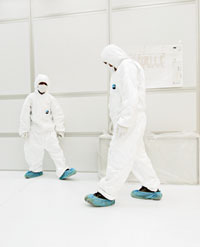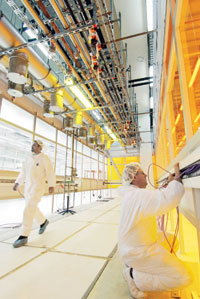KAUST
Project Credits
Project:King Abdullah University of Science and Technology (KAUST), Thuwal, Saudi Arabia Sources
Concrete: GRC System Building |
A comprehensive irrigation plan allocates water-reclamation loads from condensate, storm, gray, and black water to satisfy a majority of the irrigation requirements, which would have been less if HOK's original xeriscaping design was implemented. An on-site desalination plant creates potable water from the sea, though the process is energy-intensive.
Since opening its doors in September 2009, KAUST has become the first built project in Saudi Arabia to achieve LEED certification, and the largest in the world to attain LEED Platinum. Though this is a major accomplishment in some respects, and definitely a step in the right direction for a country whose oil-based economy has served it very well until now, there is an inherent irony in the story. Creating a city out of nothing so remote from much of its own country's population, and farther still from the professors and students with whom it wishes to collaborate, defies the very notion of sustainability. Filling the campus with high-energy-intensity lab buildings - despite the well-intentioned research conducted within them - in one of the world's most extreme climates, seems counterintuitive; blanketing parts of its desert site in turf grass and adding a golf course, downright absurd.
These were decisions beyond HOK's control. It was charged with making the design, construction, and operation of the buildings themselves as sustainable as possible within the project's accelerated time frame. Despite the fact that construction of the buildings used more than 16 million cubic feet of conventional concrete and all of the buildings' interior spaces require air-conditioning, the project still managed to garner the highest possible LEED rating, which speaks to obvious shortcomings of LEED, not HOK's sustainable-design efforts. KAUST's administrative buildings are said to use up to 40 percent less energy than the U.S. standard, its lab buildings 20 to 25 less - statistics that clearly point to deficiencies in construction here in the United States, not in Saudi Arabia.
| MAKING IT WORK | |||||
A fast-track project for a desert startup led to collaboration around the globe. Abbie Gregg is the owner of AGI, an Arizona-based firm that provides engineering and consulting services for advanced technology industries. She and her staff traveled frequently to Saudi Arabia to provide on-site support for construction of KAUST's state-of-the-art research and laboratory facilities. Josephine Minutillo: How did you get involved with KAUST? JM: You traveled there much more than the architects did. Why? JM: What were the specific challenges of being a woman on this job? JM: Was it difficult then for some of the men who are not used to working with women to collaborate with your team? JM: Would you do it again? |
|||||










